Looking for a dementia-friendly gift idea? A coloring book could be a great choice, but not just any coloring book will do: Here are the top five things to look for in a coloring book for your loved one with dementia or Alzheimer’s, along with some of our favorites.
Coloring is an honorable hobby with major benefits — often us as adults have not colored in decades, outside of keeping kids entertained while waiting for the food to arrive at a restaurant. Those with dementia are re-learning the joy of coloring just as we might, and studies have shown that coloring for just 20 minutes a day can increase mindfulness, reduce stress and improve one’s mood. Accordingly, a niche market of adult coloring books has exploded into the mainstream. (See: Boss Babes, a coloring book featuring female figures of influence from Beyoncé to Ruth Bader Ginsberg, the full series of “Snarky Adult Coloring Books”, or Calm the F*ck Down: An Irreverent Adult Coloring Book, which made the list of Oprah’s 25 favorites.)
Just as the mental health benefits of coloring span the age spectrum, they span the spectrum of cognitive health, including adults living with Alzheimer’s and other types of dementia. One small study found evidence that performing art therapy-related activities with caregivers, including coloring, may be able to help dementia’s behavioral and psychological symptoms, improve social skills and lighten the load for caregivers.
“Coloring in is not a passive act,” Philippa Perry, a psychotherapist, wrote in her piece for The Guardian. “You need to make creative decisions about which colors to choose and, while you concentrate on not going over the lines, other parts of your mind may be freed up in ways that allow you to become more creative.”
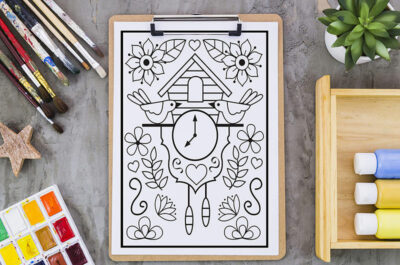
Encourage the inner artist in your loved one with this advice.
There are motor skill benefits, too: Using soft pens or pencils that are easy to hold has also shown to improve finger flexibility and hand-eye coordination in the participant, fostering improved communication between them and their caregivers. We recommend Double-Sided Colored Pencils to help with color selection for your loved ones. Complimentary colors are located on the same pencil, and simplifying 24 colors to 12 pencils can prevent overwhelm and distraction. To create accessibility for loved one’s with greater dementia progression, Colored Pencil Finger Grips or the Ergonomic Pencil Grip can be added to art utensils to reduce hand strain and facilitate re-learning of writing skills with guided hand placement. These sturdy and durable Adult Crayons are a fantastic addition to your loved one’s art supplies, as they self-sharpen by pulling a string. Selecting art supplies that are designed for user accessibility will allow your loved one to develop and maintain art skills. There is a large market for art supplies for children with disabilities, which is a resource for the dementia and Alzheimer’s community. Before purchasing any art supplies, check the dimensions and photo reviews of products to assure suitability for your loved one.
 Setting up an artist station in your home may encourage your loved one to use coloring as their preferred activity. If art supplies are out of sight, they are likely out of mind. Using containers or jars to display colored pencils will increase the accessibility and visibility of the materials. Open containers for art supplies will support color selection and activity focus as well. If your loved one lives in a residential facility or attends a day center, assembling a tote bag with art supplies and coloring pages can be very beneficial. But when it comes to finding the best coloring medium for someone with dementia, not all books are created equal.
Setting up an artist station in your home may encourage your loved one to use coloring as their preferred activity. If art supplies are out of sight, they are likely out of mind. Using containers or jars to display colored pencils will increase the accessibility and visibility of the materials. Open containers for art supplies will support color selection and activity focus as well. If your loved one lives in a residential facility or attends a day center, assembling a tote bag with art supplies and coloring pages can be very beneficial. But when it comes to finding the best coloring medium for someone with dementia, not all books are created equal.
Here, we highlight the top five things to look for.
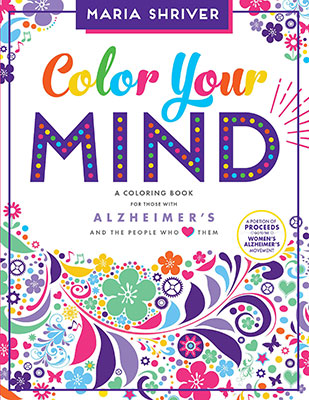 1. Understanding the Person with Dementia’s Needs
1. Understanding the Person with Dementia’s Needs
Take note of your loved one’s visual acuity, concentration level, motor skills and what brings them joy. All of these factor into the coloring experience and must not be overlooked when purchasing a book. It is recommended to cross out any diagnoses on coloring book covers, to preserve the dignity of the user. Maria Shriver’s Color Your Mind: A Coloring Book for Those with Alzheimer’s and the People Who Love Them, is a great option for someone with mild cognitive impairment, but not for someone who is further along in their dementia progression, as some of the text and images prove to be a bit complex. The book provides Caregivers with activities and conversation starters to forge connections with their loved one.
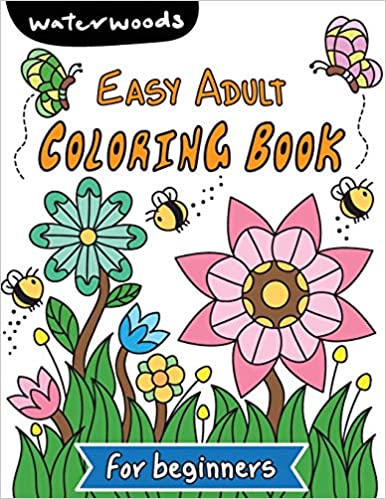 2. Keep it Simple
2. Keep it Simple
Coloring is meant to be a soothing activity, but often books can showcase complex designs that require great attention to detail and skill. Simpler designs with uncomplicated details are best for those with dementia. Choose a book with larger images, making sure to avoid intricate details and surrealistic, dream-like templates, which may confuse or irritate the colorer. Easy Coloring Book for Adults: Beautiful Simple Designs for Seniors and Beginners contains 44 unique, yet uncomplicated designs like plants, butterflies and nature scenes, which promote stress release and relaxation. For loved ones in earlier stage progression, complexity may be more appealing to not feel infantilized. For advanced dementia artists, or individuals with an artist’s background, intricate designs may be a more appropriate project.
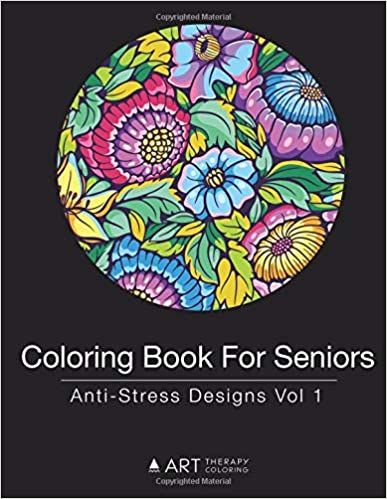 3. Bigger is Better
3. Bigger is Better
Look for books with larger spaces to color instead of small, intricate details which can create unnecessary strain on eyes, or prove difficult for those with hand control issues. Pick images with thick, dark lines that are fairly easy to color within, so that there isn’t the need for super-fine markers or pens. The Coloring Book For Seniors: Anti-Stress Designs contains beautiful designs that are zoomed in so they are easier to see and color, making it a great option for those with vision troubles or decreased motor skills.
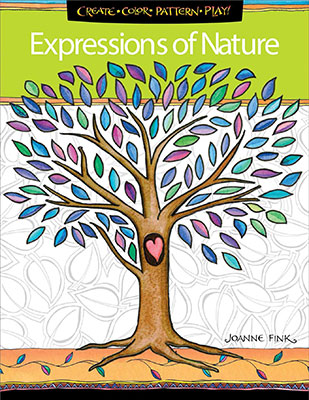 4. One-Sided Pages with Thick Paper
4. One-Sided Pages with Thick Paper
This tip may sound insignificant, but it can make or break the experience: Making sure the book has thick paper and is not double-sided will prevent bleed-through and make it suitable for marker pens. Added bonus: you can remove the page to frame the image or give to someone as a gift. Expressions of Nature Coloring Book: Create, Color, Pattern, Play contains single-side, perforated page designs on extra-thick paper, which detach easily so can remove your art once it’s done, to frame or gift.
 5. Meaningful Subject Matter
5. Meaningful Subject Matter
Learn what your loved one most enjoys and find them a book that taps into that. If they find joy in nature, for example, buying a book that has images of the outdoors will not only fulfill their coloring needs, but also will serve as a vessel to spark memories. Nostalgic subject matter — like delicious food, animals and imagery that evokes the 1960s — may prompt reminiscing. Not every image will resonate with every individual, but with diversity in book themes increases the likelihood they’ll find something to connect with. For the art history buff, the Famous Paintings Coloring Book: 24 Classics may be an exciting path to rediscover favorite artists such as Monet, Klimt, Gauguin, Da Vinci, and Picasso. Framing your loved one’s completed pieces, or hanging their art on the wall or fridge celebrates creativity.
Be cautious about selecting a coloring book with a diagnosis on the cover. Your loved one may be less motivated to be involved in art if the book is marketed towards seniors or those with dementia. Simply removing the cover and book binding to create loose leaf coloring sheets, or using a marker to cross off “diagnostic labeling language” is recommended. Loose leaf coloring sheets are encouraged for simplifying coloring sheet selection options from a book to one page for your elder, and Crayola provides Free Printable Coloring Pages for Adults on their website. At-home printable coloring sheets are a cost effective way to gauge your loved one’s interest in art involvement, and can allow for symptom tracking and progression observation. By printing out multiple copies of one coloring sheet, your loved one can color them once a week or once a month, and the drawings can be compared and analyzed at doctor’s appointments.
For those wanting to connect with your loved one with a stress-relieving activity, the Mindfulness Coloring Book is a great option. Each coloring sheet comes with an inspirational message, uplifting quotes and thinking prompts on the left and a coloring page on the right. The images range from simple to complex, so your loved one can select which drawing appeals to them each day. Although complex images may be difficult to complete, it is crucial to remember that in many ways, complexity provides dignity for your loved one. As the friend, family member, or care provider, it is your role to select what level of coloring complexity will engage your loved one without eliciting self-doubt and frustration. Finding a coloring book with a variety of skill-levels will be a support to your loved one, and will allow space for the fluctuation in cognitive ability, without being a barrier to creating art.
If you are a caregiver looking for a coloring book of your own to draw alongside your loved one, we recommend Johanna Basford’s: Secret Garden, the global phenomenon and multi-million-copy bestselling book. A critical part of caregiving is self-care, so engage with the benefits of artistic expression for stress reduction.
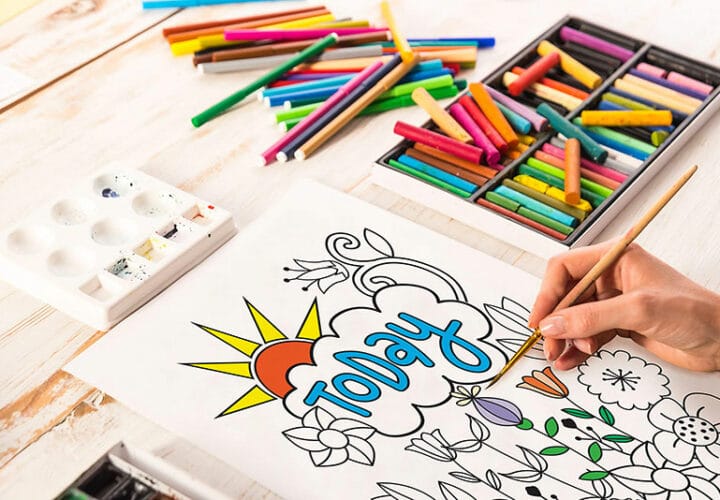


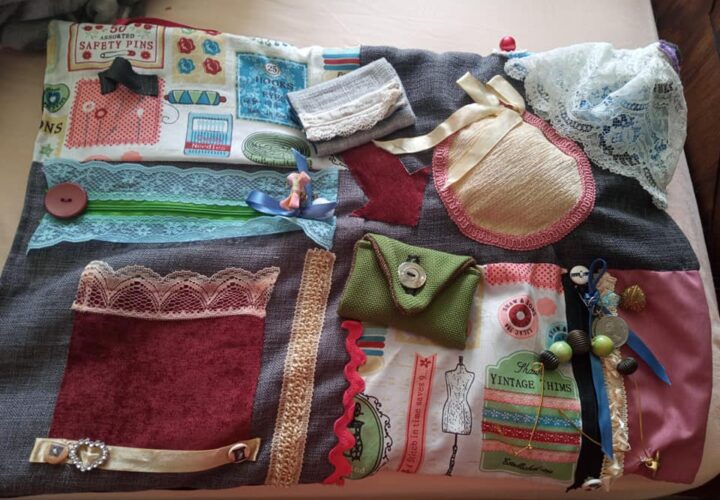

I would like to buy a coloring book for someone who has dementia but I do not want that reference made on the book because then they will not use it. Do you have one that leaves that information off?
Hi Joanne, thank you for being here! We have now updated the article to include a selection of coloring books designed with sensitivity for those with dementia, ensuring there are options without direct references on the cover.
I would like a colouring book which gives suggestions for colours to be used eg a coloured picture with a blank to fill in. Also no reference to dementia
I agree 100%. I am going to use a dark black marker to color the offending word out. It is an OFFENSIVE word to the people who are receiving the book. Why do the makers of these books not realize that?
Hi Miri, we’ve understand your concerns and have since updated the article to better reflect sensitivity towards all individuals. Thank you for reading!
Agree completely with the two comments , made years apart, Why label the book with the illness????? Is it really necessary to put “Dementia “ on the cover??? In the title of the book/activity?? Give the elderly & dementia sufferers their DIGNITY!!
Hi Tracey, thank you for your feedback. We’ve recently updated article with new coloring book selections, focusing on inclusivity and sensitivity for all stages of dementia. We hope this helps!
Just agreeing with all those above. I won’t be getting so many of these simply because of the reference to dementia or Alzheimer’s on the cover. Why would anyone who really cares about this think this is a good idea? Dementia patients aren’t stupid, they’re just ill.
We’ve listened to your feedback and updated our article with new, thoughtful selections for coloring books, focusing on inclusivity and sensitivity for all stages of dementia. Thank you for being part of this community, George!